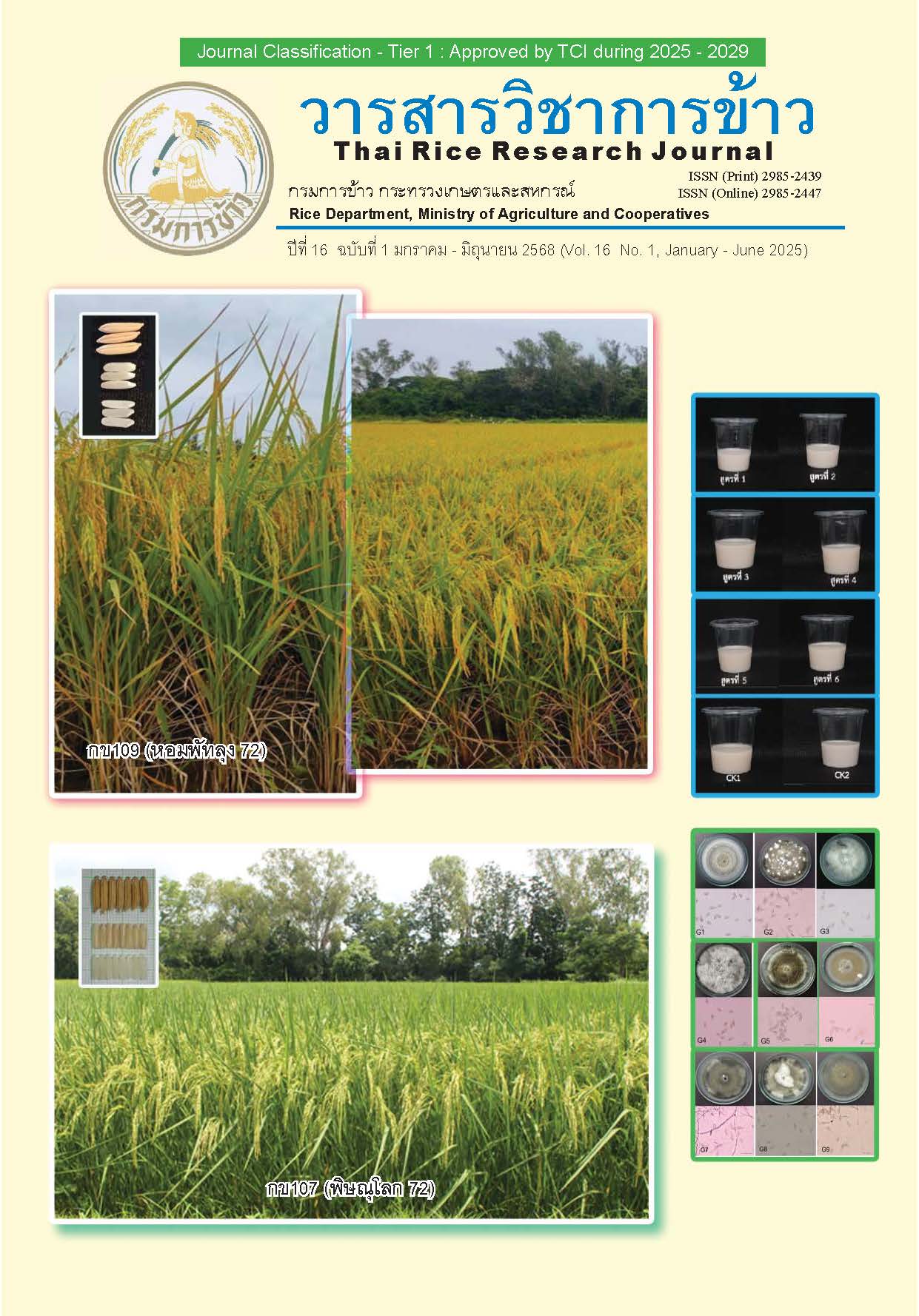Physical and Chemical Properties of Tropical Soil for Rice Cultivation in Upper Northern Thailand during Wet Season, 2020/2021
Main Article Content
Abstract
The upper northern region of Thailand, comprising eight provinces, has been classified into land suitability classes for rice cultivation as follows: highly suitable (S1; 1.9 million rai), moderately suitable (S2; 1.3 million rai), marginally suitable (S3; 320,000 rai), and unsuitable (N; 660,000 rai). This study aimed to analyze the physical and chemical properties of paddy soils in this region during the 2020/2021 wet season to provide a scientific basis for appropriate soil and fertilizer management for sustainable glutinous rice production. Soil samples were collected using purposive sampling and analyzed for their physical and chemical characteristics at the Phrae Rice Research Center laboratory. The results revealed that sandy loam was the most common soil texture, accounting for 43% of all samples. While this texture offers good drainage, it has limitations in retaining water and nutrients. Conversely, clay soils, which have high potential for moisture and nutrient retention, were found in very small proportions. Significant differences in chemical properties were observed among the land suitability classes. S1 soils had median values of organic matter at 2.34% (IQR: 1.76-2.92), available phosphorus at 12 mg/kg (7-23), exchangeable potassium at 81 mg/kg (47-120), and soil pH at 5.61 (5.16-6.17). S2 soils showed lower nutrient levels and higher acidity, with organic matter at 2.05% (1.59-2.58), phosphorus at 11 mg/kg (6-26), exchangeable potassium at 80 mg/kg (52-113), and pH at 5.31 (4.97-5.95), particularly in Chiang Rai and Lampang. S3 soils had the highest available phosphorus content at 30 mg/kg (15-66), with 2.18% organic matter (1.68-2.68), 88 mg/kg exchangeable potassium (52-143) and pH 5.61 (5.05-6.24). N-classified soils had organic matter at 2.12% (1.57-2.58), available phosphorus at 16 mg/kg (7-40), exchangeable potassium at 80 mg/kg (48-115), and pH 5.64 (5.08-6.17). The findings support that fertilizer application based on soil test results can improve nutrient use efficiency, reduce production costs and prevent excessive nutrient accumulation. In particular, phosphate fertilizer application should be reduced in S3 areas where phosphorus accumulation is high. This fertilizer management approach has the potential to enhance glutinous rice production in the upper northern region of Thailand.
Article Details
References
กรมการข้าว. 2552. คำแนะนำการใช้ปุ๋ยตามค่าวิเคราะห์ดิน. สำนักวิจัยและพัฒนาข้าว กรมการข้าว, กระทรวงเกษตรและสหกรณ์. กรุงเทพฯ. 90 หน้า.
กรมพัฒนาที่ดิน. 2562. คู่มือการวิเคราะห์ดินทางเคมีเพื่อประเมินความอุดมสมบูรณ์ของดิน. สำนักวิทยาศาสตร์เพื่อการพัฒนาที่ดิน กรมพัฒนาที่ดิน, กระทรวงเกษตรและสหกรณ์. 102 หน้า.
ทศนัศว์ รัตนแก้ว. 2567. การใช้ข้อมูลการรับรู้ระยะไกลเพื่อศึกษาสมบัติบางประการของดินในพื้นที่เสี่ยงการเป็นดินกรดและดินเค็มภาคกลางของประเทศไทย. วารสารวิจัยและส่งเสริมวิชาการเกษตร 41(2): 157-174.
สำนักงานเศรษฐกิจการเกษตร. 2567. ข้อมูลการผลิตสินค้าเกษตรปี 2555-2565. สืบค้นจาก: https://www.oae.go.th/view/1/%E0%B8%95%E0%B8%B2%E0%B8%A3%E0%B8%B2/TH-TH. (23 กรกฎาคม 2567)
Agri-map online. 2563. ระบบแผนที่เกษตรเพื่อการบริหารจัดการเชิงรุกออนไลน์. สืบค้นจาก: https://agri-maponline.moac.go.th/. (12 พฤษภาคม 2563)
Almendros, G., H. Knicker and F.J. Gonzalez-Vela. 2003. Rearrangement of carbon and nitrogen forms in peat after progressive thermal oxidation as determined by solid state C-13 and N-15-NMR spectroscopy. Organic Geochemistry 34: 1559-1568.
AOAC. 1991. Quality Assurance Principle for Analytical Laboratories. 2nd eds. Rockville, Maryland: Association of Official Analytical Chemists.
Arunrat, N., S. Sereenonchai, P. Kongsurakan and R. Hatano. 2022. Assessing soil organic carbon, soil nutrients and soil erodibility under terraced paddy fields and upland rice in northern Thailand. Agronomy 12(2): 537.
Chakravarty, M., D.J. Nath and U.J. Sarma. 2023. Physicochemical properties of long-term ricefallow cultivation and uncultivated soils of Nalbari, Assam, India. International Journal of Plant & Soil Science 35(20): 1362-1369.
Chen, Q., Y. Song, Y. An, Y. Lu and G. Zhong. 2024. Soil microorganisms: Their role in enhancing crop nutrition and health. Diversity 16(12): 734.
Day, P.R. 1965. Particle fractionation and particle-size analysis. pp. 545-567. In: C.A. Black (ed.), Method of Soil Analysis. Part I. Agronomy Monograghs No. 9. American Society of Agronomy Inc., Madison, Wisconsin.
Dou, F., J. Soriano, R.E. Tabien and K. Chen. 2016. Soil texture and cultivar effects on rice (Oryza sativa, L.) grain yield, yield components and water productivity in three water regimes. PLOS One 11(3): e0150549.
Hossain, I. 2014. Correlation of available phosphorus and potassium with pH and organic matter content in the different forested soils of Chittagong Hill Tracts, Bangladesh. International Journal of Forest, Soil and Erosion 4(1): 7-10.
Jayara, A.S., S. Pandey and B.K. Ambasta. 2021. Physico-chemical properties of soil and its relationship with soil health. Chemical Science Review and Letters 10(37): 9-16.
Kome, G.K., R.K. Enang, F.O. Tabi and B.P.K. Yerima. 2019. Influence of clay minerals on some soil fertility attributes: A review. Open Journal of Soil Science 9(9): 155-188.
Niederberger, J., M. Kohler and J. Bauhus. 2019. Distribution of phosphorus fractions with different plant availability in German forest soils and their relationship with common soil properties and foliar P contents. SOIL 5(2): 189-204.
Oechaiyaphum, K., H. Ullah, R.P. Shrestha and A. Datta. 2020. Impact of long-term agricultural management practices on soil organic carbon and soil fertility of paddy fields in northeastern Thailand. Geoderma Regional 22.
Srinivasan, R., D.C. Nayak, R. Gobinath, S.N. Kumar, D.V.K.N. Rao and S.K. Singh. 2022. Consequential rice crop response to resultant soil properties in a toposequence in eastern coastal plain of Odisha, India. Modeling Earth Systems and Environment.
USDA. 2024. Rece production. Available source: https://ipad.fas.usda.gov/. (July 20, 2024)
Wicharuck, S., N. Khongdee, N. Mawan and K. Stahr. 2023. Soil erosion assessment under different land use types using modified Gerlach trough in northwestern Thailand highland. Soil Science Annual 74(1): 163079.
Yamane, T. 1967. Statistics, An Introductory Analysis. 2nd eds. Harper and Row. New York. 919 p.
Ye, C., G. Zheng, Y. Tao, Y. Xu, G. Chu, C. Xu, S. Chen, Y. Liu, X. Zhang and D. Wang. 2024. Effect of soil texture on soil nutrient status and rice nutrient absorption in paddy soils. Agronomy 14(6): 1339.
